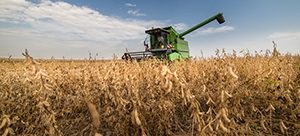 Back to All Insights
Back to All Insights

Soybean Storage Tips
Mar 4, 2019
Agronomy, Crop Management, Grain, Market Update, Soybean, Technology
On-farm storage can help a producer ride out some of the waves of market volatility, providing more marketing control. However, an improperly stored and managed soybean crop can be a greater detriment to a producer’s bottom line than soft prices.
Hank Brown, Pillsbury Location Manager for Arthur Companies, shares that producers should take extra caution with their stored soybeans as we head into spring.

“Eastern North Dakota experienced a wet and prolonged soybean harvest, and based on our inbound grain receipts, we estimate that in some areas over half of the soybean crop was harvested above 13% moisture. This creates a lot of challenges for the management of soybeans post-harvest.”
Based on Mother Nature’s lack of cooperation, Brown advises that producers remain diligent in monitoring their stored soybean crop and suggests a checklist of considerations and questions every producer should review.
How are soybeans being stored on your farm?
Storage infrastructure is the first pre-harvest consideration every producer should make. Soybeans stored in bags or smaller, satellite bins with no fans will require more management and closer observation than a crop stored in larger, well ventilated bins and should be the first of the crop to leave the farm.
How long will soybeans be stored?
Soybeans that are intended to be sold in the spring should not exceed 13% moisture while stored. Beyond 70 days of storage, that percentage falls to 11%.
Was crop quality compromised during harvest?
Soybeans with seed coat cracks, either from mechanical damage and or shatter loss, allow molds to develop more rapidly and accelerate deterioration.
Do you have the ability to aerate and cool stored soybeans?
To maintain oil quality, mitigate mold growth, and kill insects, soybeans should be cooled and maintained at temperatures between 20 and 30 degrees in the winter and aerated in the spring to ensure that temperatures never exceed 40 degrees. Soybeans should be cooled when the average outdoor temperature is 10 to 15 degrees cooler than the stored crop.

Remember that cooling soybeans as outdoor temperatures cool reduces moisture migration and condensation; with each 10 degree reduction in grain temperature, storage time approximately doubles.
Temperature cables can and should be used, however, remember that technology cannot replace management. It is important to evaluate stored crops frequently, especially during the coldest parts of the winter when grain temperatures and moisture contents need to be managed more closely.




